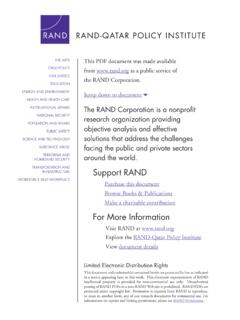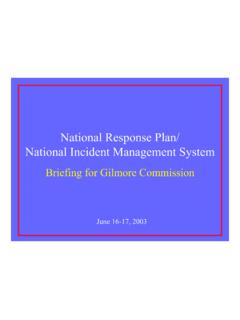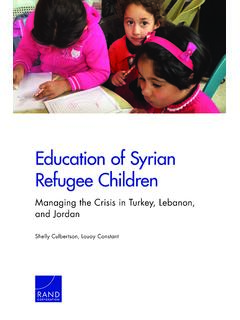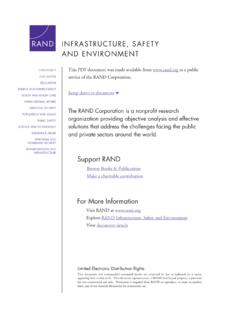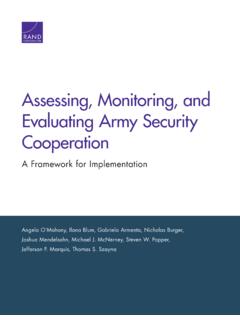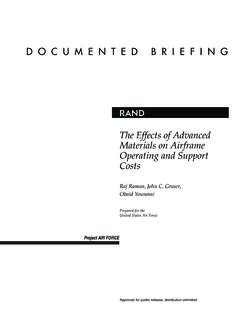Transcription of HE FUTURE The Future of - RAND Corporation
1 THE FUTURE OF WARFAREThe FUTURE of Warfare in 2030 Project Overview and ConclusionsRAPHAEL S. COHEN, NATHAN CHANDLER, SHIRA EFRON, BRYAN FREDERICK, EUGENIU HAN, KURT KLEIN, FORREST E. MORGAN, ASHLEY L. RHOADES, HOWARD J. SHATZ, AND YULIYA SHOKHCORPORATIONRTHE FUTURE OF WARFAREThe FUTURE of Warfare in 2030 Cohen et Print and Electronic Distribution RightsThis document and trademark(s) contained herein are protected by law. This representation of rand intellectual property is provided for noncommercial use only. Unauthorized posting of this publication online is prohibited. Permission is given to duplicate this document for personal use only, as long as it is unaltered and complete. Permission is required from rand to reproduce, or reuse in another form, any of its research documents for commercial use.
2 For information on reprint and linking permissions, please visit rand Corporation is a research organization that develops solutions to public policy challenges to help make communities throughout the world safer and more secure, healthier and more prosperous. rand is nonprofit, nonpartisan, and committed to the public interest. rand s publications do not necessarily reflect the opinions of its research clients and RANDMake a tax-deductible charitable contribution at of Congress Cataloging-in-Publication Data is available for this : 978-1-9774-0295-0 For more information on this publication, visit by the rand Corporation , Santa Monica, Calif. Copyright 2020 rand CorporationR is a registered , spine: combo1982/Getty Images, matejmo/Getty Images, StudioM1/Getty ImagesiiiPrefaceWhere will the next war occur?
3 Who will fight in it? Why will it occur? How will it be fought? Researchers with R AND Project AIR FORCE s Strategy and Doctrine Program attempted to answer these questions about the FUTURE of warfare specifically, those conflicts that will drive a and Air Force response by examining the key geopo-litical, economic, environmental, geographic, legal , informational, and military trends that will shape the contours of conflict between now and 2030. This report is one of a series that grew out of this effort. The other reports in this series are Raphael S. Cohen, Eugeniu Han, and Ashley L. Rhoades,Geopolitical Trends and the FUTURE of Warfare: The ChangingGlobal Environment and Its Implications for the Air Force(RR-2849/2-AF) Forrest E. Morgan and Raphael S. Cohen, Military Trends andthe FUTURE of Warfare: The Changing Global Environment and ItsImplications for the Air Force (RR-2849/3-AF) Howard J.
4 Shatz and Nathan Chandler, Global Economic Trendsand the FUTURE of Warfare: The Changing Global Environment andIts Implications for the Air Force (RR-2849/4-AF) Shira Efron, Kurt Klein, and Raphael S. Cohen, Environment,Geography, and the FUTURE of Warfare: The Changing Global Envi-ronment and Its Implications for the Air Force (RR-2849/5-AF) Bryan Frederick and Nathan Chandler, Restraint and the Futureof Warfare: The Changing Global Environment and Its Implicationsfor the Air Force (RR-2849/6-AF).iv The FUTURE of Warfare in 2030: Project Overview and ConclusionsThis volume introduces the overall definitions, methodology, findings and the larger implications for the Air Force in particular and the joint force at large that are used in the series of reports. This research was sponsored by the Director of Strategy, Con-cepts and Assessments, Deputy Chief of Staff for Strategic Plans and Requirements (AF/A5S).
5 It is part of a larger study, entitled The FUTURE of Warfare, that assists the Air Force in assessing trends in the FUTURE strategic environment for the next Air Force strategy. This report should be of value to the national security community and interested members of the general public, especially those with an interest in how global trends will affect the conduct of warfare. Comments are welcome and should be sent to the project leader, Raphael S. Cohen. Research was completed in August Project AIR FORCER AND Project AIR FORCE (PAF), a division of the R AND Corpo-ration, is the Air Force s federally funded research and develop-ment center for studies and analyses. PAF provides the Air Force with independent analyses of policy alternatives affecting the development, employment, combat readiness, and support of current and FUTURE air, space, and cyber forces.
6 Research is conducted in four programs: Force Modernization and Employment; Manpower, Personnel, and Train-ing; Resource Management; and Strategy and Doctrine. The research reported here was prepared under contract information about PAF is available on our website: report documents work originally shared with the Air Force in September 2018. The draft report, issued September 7, 2018, was reviewed by formal peer reviewers and Air Force subject- matter ..iiiFigures and Tables ..viiSummary ..ixAcknowledgments ..xiAbbreviations ..xiiiCHAPTER ONEThe FUTURE of Warfare ..1 CHAPTER T WO The Failures of Forecasting the FUTURE ..5 CHAPTER THREE Studying the FUTURE and Methodology ..13 CHAPTER FOURD epicting the Key Trends ..17 CHAPTER FIVEP redicting the FUTURE of Warfare ..35 Who Fights? Fixed Adversaries; Allies in Flux.
7 35 Where Will the United States Fight? Most Likely Versus Most Dangerous ..43 What Will FUTURE Conflict Look Like? Four Archetypes of Conflicts ..50vi The FUTURE of Warfare in 2030: Project Overview and ConclusionsHow Will the United States Fight? Declining Quantitative and Qualitative Advantage ..54 When and Why Will the United States Fight? Increasing Inability to Control Strategic Outcomes ..62 CHAPTER SIXI mplications for the Air Force and the Joint Force ..69 Capability: Range, Precision, Information, and Automation ..69 Capacity: More ..71 Posture: Few Gains to Be Realized by Drawing Down in the Middle East ..72 Strategy: The Growing Need for Agility at All Levels ..73 Policy: Increasing Resilience on the Home Front ..74 The FUTURE of Warfare: A Deepening Series of Strategic Dilemmas ..74 References ..77viiFigures and TablesFigures Share of Nominal GDP of the United States, Allies, and Challengers, 1990 2017.
8 58 Projections for Share of Nominal GDP Projections of the United States, Allies, and Challengers, 2017 2030 ..59 Tables Geopolitical Trends ..18 Military Trends ..20 Space and Nuclear Trends ..23 Cyber Trends ..25 Restraint Trends ..26 Global Economic Trends ..29 Environmental Trends ..32 Fixed Adversaries ..37 Allies in Flux ..41 Where the United States Will Fight ..44 Four Types of Conflict ..51 Declining Quantitative and Qualitative Advantage ..55 An Increasing Inability to Control Strategic Outcomes ..63ixSummaryThe track record for predicting the FUTURE of warfare is notori-ously poor. Robert Gates, Secretary of Defense from 2006 to 2011, famously quipped, When it comes to predicting the nature and location of our next military engagements, since Vietnam, our record has been perfect.
9 We have never once gotten it right, from the Mayaguez to Grenada, Panama, Somalia, the Balkans, Haiti, Kuwait, Iraq, and more we had no idea a year before any of these missions that we would be so engaged. 1 And yet, for better or worse, the military is deeply invested in the forecasting business because the ser-vices need to start building today what will be needed one or even two decades from now. Thus, the question becomes how to predict the FUTURE of warfare this report, we start by exploring why the military so often fails to the predict the FUTURE correctly and find that failed pre-dictions cannot be chalked up simply to stupidity of individual lead-ers, ignorance of technology, or failure to identify trends. Rather, the failures stem from not thinking comprehensively about the factors that shape conflict and how these variables interact with one another.
10 We then develop definitions and a methodology to do just that first identifying the key three dozen or so geopolitical, economic, environ-mental, geographic, military, legal , and informational trends that will shape the FUTURE of warfare from now until 2030 and then aggregating them to paint a holistic picture of which countries the United States 1 Robert Gates, speech to the Military Academy, West Point, , February 25, The FUTURE of Warfare in 2030: Project Overview and Conclusionswill fight with and against, where these conflicts will occur, what they might look like, how the United States will wage them, and when and why the United States might go to war in the first on this analysis and assuming that the United States will continue to try to maintain its position as the world s only global mili-tary superpower, we conclude that the United States will confront a series of deepening strategic dilemmas when confronting warfare from now through 2030.

